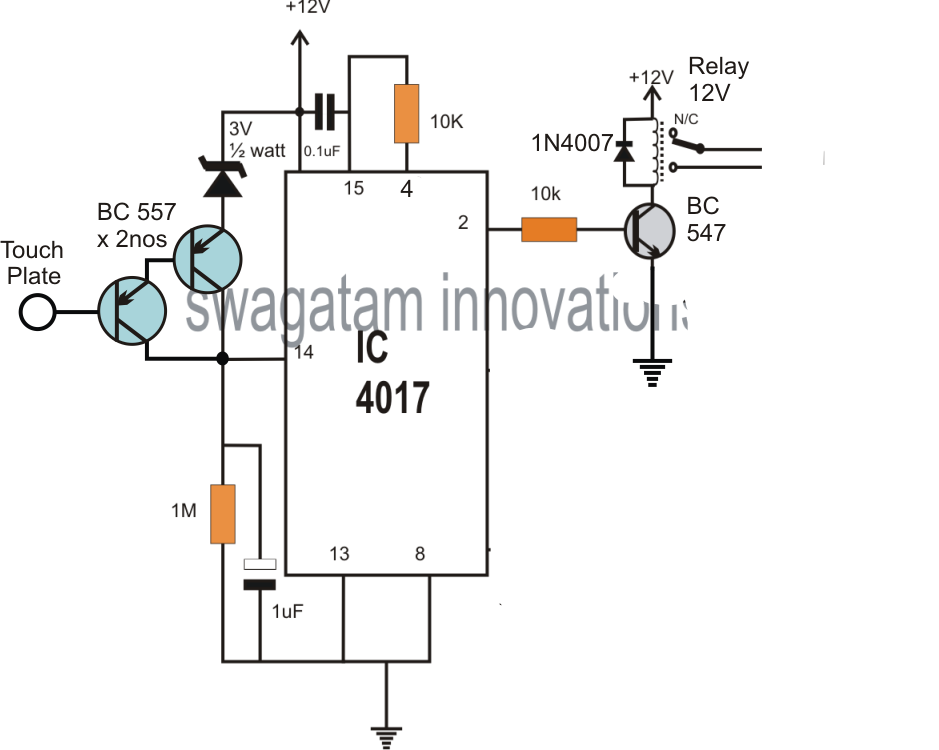A surprisingly simple touch sensor switch circuit could in fact be constructed utilizing just one IC 4017 together with a couple of supplementary passive elements, the method is spelled out in the next paragraphs .
Looking at the below presented circuit diagram for the suggested simple touch sensor switch, we are able to notice that the complete model has been designed around the IC 4017 which happens to be a 10 step johnson's decade counter divider chip.

The IC fundamentally incorporates ten outputs, originating in its pin#3 and randomly finishing off at pin#11, constituting 10 outputs which are usually intended to develop a sequencing or switching high logics across all of these output pins based on every positive signal implemented at its pin#14.
The sequencing would not really need to accomplish at the last pin#11, instead may very well be allotted pull up at any preferred in between pinout, and then go back to the first pin#3 to begin the sequence afresh.
This is simply carried out by hooking up the last sequence pinout with the reset pin#15 of the IC. That makes certain that at any time the progression gets to this pinout, the sequence quits at this point and reverts to pin#3 which happens to be the first pinout for making it possible for a recurring cycling of the phase in an exact order.
As an illustration in our model pin#4 which is the 3rd pinout in the range can be viewed linked with pin#15 of the IC, means that while the progression leaps from pin#3 to the subsequent pin#2, thereafter to pin#4 it promptly reverts or flips returning to pin#3 to make it possible for the sequence yet again.
This cycling is brought on by touching the mentioned touch plate which in turn causes a positive signal to emerge at pin#14 of the IC whenever it's touched.
Let's anticipate at power launch the high logic is at pin#3, this pin is not associated anywhere as well as being empty, whilst pin#2 can be found associated with the relay driver stage, consequently at this point the relay continues turned OFF.
The minute the touch plate is tapped, the positive voltage at pin#14 of the IC toggles the output progression which at this point leaps from pin#3 to pin#2 making it possible for the relay to activate.
The situation is retained stationary at this stage, with the relay in the turned on situation as well as the plugged in load initialized.
But the instant the touch plate is handled just as before, the cycle is compelled to bounce from pin#2 to pin#4, which stimulates the IC to go back the logic returning to pin#3, stopping of the relay along with the load and helping the IC going back to its standby mode situation.
Touch Switch Circuit Using IC 4011
This touch switch circuit using IC 4011 is built to present on/off switching for 9 volt battery controlled devices possessing a current usage of around 100mA.
Within the single touch contact which is in short , touched in an effort to differ from on to off or the other way round.
The touch switch circuit is managed through stray pick up of line hum which can be combined to the input of gate 1 (which usually such as other three gates used in the unit is linked to work as an inverter) through R1 once the input contact is touched.

As IC1 is a CMOS device it has a quite high input impedance, and the input signal will probably be effective at switching gate 1 input from one logic state to another.
The input impedance of the circuit is really higher that the reverse resistance of D1 is employed to connect the input to ground beneath quiescent situations, in order to avoid unwarranted procedure.
R1 serves like a low pass filter in addition to the input capacitance of the circuit, which attenuates high frequency noise which might be existing within the 60Hz line signal.
The output through gate 1 continue to consists of substantial sound products, as well as features a surge time which can be insufficient to drive the final stage of the circuit.
This is overcome utilizing the trigger circuit depending on gates 2 and 3. R3 is likely to keep gate 2 input within the similar state as gate 3 output, resisting any kind of change in logic state the result of gate 1 output because of the coupling via R2.
This resistance to change is known as 'hysteresis'. R2 possesses a lower value than R3, and so gate 1 can easily work the trigger circuit if its output signal is of enough amplitude.
The 60Hz signal will probably be powerful enough, however the noise spikes will never, and they are hence eradicated through the output of the trigger.
When the output of the trigger does begin to modify state, the coupling via R3 offers a triggering action which will guarantees an instant change. IC2 is a 14 stage binary (divide by 2) counter, and Q1 is driven through the output of the seventh stage through current limit resistor R5.
C2 and R4 give a positive reset pulse to the counter at turn on so the outputs are all low, and Q1 is turned off. The governed devices forms the load for Q1, and clearly obtains no substantial power.
When the touch contact is activated, a 60 Hz signal is raised on to IC2 and the 7th stage output changes state every 64 pulses. Since this output moves higher and lower the load is turned on and off.
In process the contact is touched simply till the unit switches to the preferred state (which one is likely to perform quickly). The unit utilizes just about 1uA in the "off" mode and around 3mA in the "on" state.
Leave a Reply